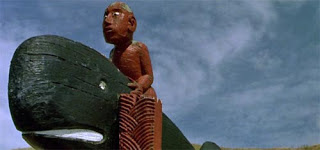Based on the feminist framework, I able to analyze how Caro may have created this film with gender roles in mind. Paikea was a young girl who was seen as weak and innocent to her grandfather, Korro. Like addressed in other posts, Pai constantly disappointed her grandfather, partially because her brother died at child birth. Pai begins to challenge the traditional Maori culture and myths of only having men as leaders. In some respects it almost seems as this leadership role picked her because of her ancestors. There are a couple parts in the film where Pai gets an overwhelming sense of spirit in nature. The most major was when she was planning on leaving New Zealand with her father and she looks to the ocean and hears " Paikea". She then experiences this again when climbing on top of the whale, she knew this was right where she was supposed to be. Although her ancestors had some guidance in her decisions, Pai was a strong young woman. She challenged the idea of obedience to her grandfather in many aspects. Pai pushed herself to learn rituals, dances, and the way of the Maori people. She even tried to prove this to Korro by performing at her school recital. Because she is a girl, Korro didnt' blink an eye at skills or determination. This rebellion showed the modernization of the Maori culture for women.
Whale Rider, can be compared to Mulan in many respects. In Mulan, the girl does not honor her family by being a "beautiful bride" and struggles to find her place as a woman. When her sickly father is asked to fight in the war, Mulan pretends to be a man to honor her family and protect her father. She finds that she is stronger than she thinks and finally seems to find her place even though it was a different path than what was accepted by her ancestors. Similarly, In Whale Rider, Pai challenges her grandfathers authority, and steps up to the plate to become the whale rider their tribe needs. Both woman overcome the societal norms and do what they know and feel is right for their families and the larger community.
Below are some specific similarities in Mulan and Paikea:
The first image shows Paikea upset after a day at school. Here she was a troubled adolescence trying to find her way and please her family. Pictured below is Mulan troubled by failing at impressing the match maker. This will cause her family dishonor.
Above are both turning points in the films. Paikea rescues the whale tooth Korro threw in the ocean, proving she has what it takes to be the whale rider. Mulan shoots a cannon at a mountain, destroying the enemy, proving she has what it takes to help protect China.
Above is a canoe full of Maori people who finally came together after a time of darkness because of Paikea. Paikea showed them that they must support one another in order for the community to thrive. We then see Mulan after she has helped save China and is looking among her people. Despite these women being seen as " damsels in distress" they take it upon themselves to save their people.

























